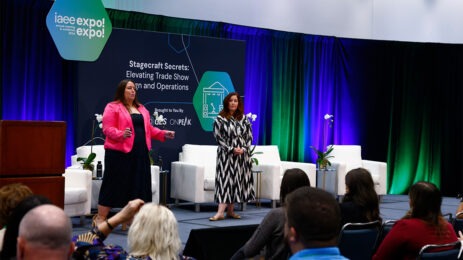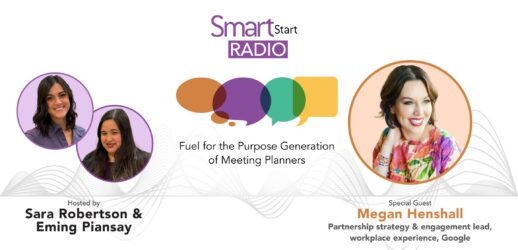Remember Jennifer Lopez in the movie The Wedding Planner? With her ever-present ear bud and microphone, she was electronically tethered to her staff, just as real-life planners often use earpieces to keep in constant touch during an event. Similarly, security teams keep attendees safe by corresponding with colleagues via headsets. And onstage, in-ear monitors are used by singers to help keep them pitch perfect. Headset technology has come a long way, and promises to add even more to the event experience of the near future.
Translation
Global Meetings Industry Day is an opportunity to embrace how our business brings people of all cultures together for one common cause. But what about language barriers? With headset technology, French, Italian and Spanish don’t have to be Greek to you.
The airline industry has recognized the potential for enhanced communication across cultures. Air New Zealand announced late last year it would be equipping crew members with Google Pixel Buds to translate conversations with passengers in 40 languages.
“We operate to 30 international destinations, and our customers speak an even more diverse range of languages,” said Avi Golan, the air carrier’s chief digital officer. “Google’s Pixel Buds could assist in areas such as check-in and boarding, as well as inflight, to help our staff communicate effectively with international customers. Both Air New Zealand and Google put people and technology at the heart of their products and experiences, and it’s been excellent exploring how translation technology…could enhance our customer experience.”
After a test phase, the airline decided to hold off on fleet-wide introduction for now. But Google Pixel Buds are not the only available option. While wearing Waverly Labs Pilot Translating Earpieces, speakers in a conversation can hear simultaneous translation in their native tongue, as well. French, Italian, Portuguese, Spanish and English are available, with plans to add more.
If someone is not wearing an earpiece, language can be translated via the company’s smartphone app. At conferences, the app can be put on speakerphone for all attendees to hear. Additional languages are available using a texting feature on the app.
Noise Cancelling
At large conferences, people have side conversations. Attendees may find it challenging to maintain focus, block out background noise and clearly hear the speaker on stage. At PCMA Convening Leaders’ Future of Face2Face in Nashville’s Music City Center in January, attendees used headsets to cancel out all the noise surrounding them in the 17,900-square-foot space for sessions and The Mix, powered by Freeman.
Think of it as tunnel vision for sound. Two options were provided, traditional headsets, and using an app on the attendee’s device and earbuds. This allowed them to tune into conference sessions and switch between presentations.
This concept is used by festival organizers who plan silent dance parties in public spaces. Attendees hear dance music via a headset, but don’t disturb anyone.
Virtual Reality
Although virtual reality (VR) engages more than your aural sense, these headsets can take you on a magic carpet ride to a whole new world or over a bridge to Terabithia without really going anywhere. Applications at meetings are still in their infancy, but planners can glimpse the future at a restaurant in Japan called First Airlines. It’s designed to look like the interior of an aircraft. The eatery prides itself in being the first virtual aviation facility to take diners to New York City, Paris, Rome or Hawaii via “ground-based air travel.”
While wearing VR headsets, guests experience the sights and sounds of these famous places through all five senses. A multicourse meal (of real, not virtual food) is served in the destination’s cuisine. No worries about turbulence on this flight!
Real airlines are already using VR headsets. In January, Japan Airlines (JAL) began offering SkyLights’ Cinematic VR Entertainment to VIP passengers, who can now enjoy movie theater-quality entertainment at 30,000 feet. And recently, Airbus, in conjunction with JAL and JAL Engineering, put Microsoft HoloLens headsets to work to train employees and solve problems by using holographic images to view data and airplane parts from any angle. Airbus also joined the Microsoft Mixed Reality Partner Program.
Air New Zealand has announced it is developing software for HoloLens. Amazingly, it promises to allow flight attendants to see passengers’ food and beverage orders, itineraries and even pick up on cues about a passenger’s mood.
Meeting professionals are finding a VR headset useful in designing room set-up. In February, AllSeated announced that its 360 RealPlans-3D is available on Facebook’s Oculus, HTC’s Vive, Samsung Gear VR and other headsets. “By bringing the collaborative realism of virtual reality to event planning, AllSeated is enabling the event community to recoup one of the biggest ROIs in the history of event technology,” says Sandy Hammer, the company’s co-founder and chief marketing officer. “Some of our customers report closing more than 10 new events a year solely due to event visualization.”
The technology helps venues and planners visualize how an event will look without a sketch pad, moving heavy furniture or traveling for an in-person site visit. “Imagine a prestigious venue that has a spectacular ballroom, beautiful chandeliers, and a magical marble and imperial staircase that gracefully rises from the floor,” says Jim Bruels, director of events and sales at Bently Reserve, an event space in San Francisco. “With AllSeated’s virtual reality, we can transport clients into our venue from anywhere in the world, immersing them in an authentic sensory experience that truly lets them visualize their event. We can sell them the experience on the spot.”




